The Neuroscience of Mindfulness by Stan Rodski

Author:Stan Rodski [Rodski, Stan]
Language: eng
Format: epub
ISBN: 9781460708316
Publisher: HarperCollins
Published: 2018-11-22T00:00:00+00:00
2.
3.
Are they positive or negative?
Pick one of them and describe it in detail.
What implicit memory might be associated with this explicit memory?
Are there any feelings that arise when you remember this memory?
If possible, talk to someone else who was present when you had this experience. They may remember it differently, which may prompt you to reassess it.
ENERGY MANAGEMENT 1: PHYSICAL ENERGY
In Part 1 we learned that while mindfulness is important in relaxing our brain, just as important is helping it work effectively through managing our energy levels, which will in turn help reduce stress and improve your mood.
Itâs hardly news that inadequate nutrition, exercise and rest diminish peopleâs basic energy levels, as well as their ability to manage their emotions and focus their attention. But many people donât find ways to practise consistently healthy behaviours, given all the demands in their lives.
George worked for a large international organisation. He was significantly overweight, ate poorly, lacked a regular exercise routine, worked long hours, and typically slept no more than five to six hours a night.
After he started seeing me, George began cardiovascular activity at least three times a week and strength training at least once. (Research shows that non-competitive, predictable and rhythmic exercise tends to be the most effective in improving your mood and reducing your anxiety. Good exercises to pursue include hatha yoga, walking and swimming.)
George started going to bed at a designated time and sleeping longer. He also changed his eating habits from two big meals a day (when he normally âgorged himselfâ, he said) to smaller meals and light snacks every three hours. The aim was to help him stabilise his glucose levels over the course of the day, avoiding peaks and valleys. He lost 12 kilos in the process, and his energy levels soared. âI used to schedule tough projects for the morning, when I knew that I would be more focused,â George told me. âI donât have to do that any more, because I find that Iâm just as focused at 5pm as 8am.â
Another key ritual George adopted was to take brief but regular breaks at specific intervals throughout the workday â always leaving his desk. The value of such breaks is grounded in our physiology.
We saw in Part 2 that ultradian rhythms refer to 90- to 120-minute cycles during which our bodies slowly move from a state of high energy into a physiological trough. Towards the end of each cycle, the body begins to crave a period of recovery.
The signals include:
Physical restlessness
Yawning
Hunger
Difficulty concentrating
Many of us ignore these signs and keep working. The consequence is that our energy reservoir only becomes further depleted as the day wears on.
My research has found that intermittent breaks for renewal result in higher and more sustainable performance. The length of the breaks is less important than the quality. Itâs possible to get a great deal of recovery in a short time â as little as several minutes â if it involves a ritual that allows you to disengage from work and truly change channels.
Download
This site does not store any files on its server. We only index and link to content provided by other sites. Please contact the content providers to delete copyright contents if any and email us, we'll remove relevant links or contents immediately.
Sapiens: A Brief History of Humankind by Yuval Noah Harari(14315)
The Tidewater Tales by John Barth(12625)
Mastermind: How to Think Like Sherlock Holmes by Maria Konnikova(7278)
Do No Harm Stories of Life, Death and Brain Surgery by Henry Marsh(6905)
The Thirst by Nesbo Jo(6877)
Why We Sleep: Unlocking the Power of Sleep and Dreams by Matthew Walker(6654)
Life 3.0: Being Human in the Age of Artificial Intelligence by Tegmark Max(5510)
Sapiens by Yuval Noah Harari(5321)
The Longevity Diet by Valter Longo(5039)
The Body: A Guide for Occupants by Bill Bryson(5027)
The Rules Do Not Apply by Ariel Levy(4908)
The Immortal Life of Henrietta Lacks by Rebecca Skloot(4548)
Animal Frequency by Melissa Alvarez(4424)
Why We Sleep by Matthew Walker(4394)
The Hacking of the American Mind by Robert H. Lustig(4338)
Yoga Anatomy by Kaminoff Leslie(4332)
All Creatures Great and Small by James Herriot(4268)
Double Down (Diary of a Wimpy Kid Book 11) by Jeff Kinney(4240)
Embedded Programming with Modern C++ Cookbook by Igor Viarheichyk(4139)
